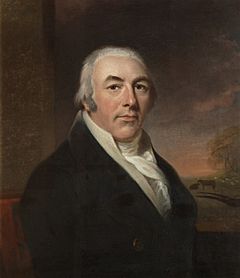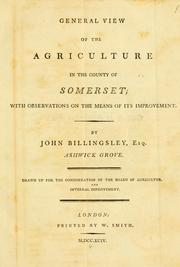John Billingsley (agriculturist) facts for kids
Quick facts for kids
John Billingsley
|
|
|---|---|

Painting of John Billingsley (1747–1811) painted by Joseph Hutchinson (1747–1830). Oil on canvas, 63.5 x 53.4 cm
|
|
| Born | 1747 Ashwick, Somerset
|
| Died | 26 September 1811 Ashwick, Somerset
|
| Nationality | British |
| Occupation | Agricultural pioneer |
| Known for | 1795 survey of agriculture in Somerset |
John Billingsley (1747–1811) was an important farmer and agricultural expert in the 1700s. He lived in Somerset, England. He wrote a famous survey about farming in Somerset in 1794. Billingsley was also a founder of the Bath and West Society. This group, now called the Royal Bath and West of England Society, helps improve farming methods. He lived his whole life at Ashwick Grove.
Contents
Early Life and Family
John Billingsley was born in 1747. His grandfather, Nicholas Billingsley, was a church minister in Ashwick. We don't know much about John's early life. By 1782, he was listed as a brewer at the Oakhill Brewery. This brewery was in the nearby village of Oakhill. He might have worked in the wool trade before that.
Billingsley was a leading member of the Presbyterian church. Later in his life, he became part of the Church of England.
Improving Farming in Somerset
The 1700s were mostly peaceful in Somerset. However, the Industrial Revolution in other parts of England changed many local industries. Farming continued to be important. John Billingsley himself farmed about 4,000 acres (16 square kilometers).
The Royal Bath and West of England Society was started in 1777. Its goal was to make farming better. Despite this, Billingsley felt more improvements were needed. In 1795, he wrote a detailed survey for the Board of Agriculture. This survey was called General View of the Agriculture of the County of Somerset.
What the Survey Found
Billingsley's survey looked at how land was used in Somerset. He estimated that over half of the county's one million acres (4,000 square kilometers) was enclosed land for meadows and pastures. A large part was also enclosed land for growing crops. He noted that about 65,000 acres (260 square kilometers) were unused "wastes."
The book suggested modern ways to farm. This included using machines more often. It also gave tips for building hedges and rotating crops. Billingsley even shared advice on treating sick animals and growing better cucumbers! The book also talked about Britain's food supply. This was important because a war with France had started in 1793.
Dividing the County
Billingsley divided Somerset into three farming areas: north-east, middle, and south-west. For the middle section, he suggested better drainage. This included making parts of the River Brue, River Axe, and River Parrett straighter. These plans helped reclaim land in the Somerset Levels. He also worried that many farmers were not adding manure to their land. This made the soil tired from growing crops all the time.
In 1798, he wrote about the special "water-meadows" in the Brendon Hills and Quantock Hills. He thought they were the best in the country.
Other Contributions
John Billingsley was also involved in building roads and canals. He helped with projects like the Kennet and Avon Canal and the Somerset Coal Canal. One person, Sir Benjamin Hobhouse, even joked that Billingsley had "drained Sedgemoor and enclosed Mendip!" This showed how much people respected his work.
Billingsley also helped introduce a new farming tool. He was responsible for bringing in and encouraging the use of the double-furrow plough. This plough helped farmers work the land faster.
One of his biggest achievements was the enclosure of the Mendip Hills. This meant turning shared land into private fields. By 1794, Billingsley estimated that 13,600 acres (55 square kilometers) had been enclosed with Dry stone walls.
Memorials
You can find two memorial tablets for John Billingsley and his family. They are located in the Church of St James, Ashwick.
After he passed away, the Bath and West Society asked an artist named Samuel Woodforde to paint his portrait. Another painting of Billingsley by Joseph Hutchinson is now in the Victoria Art Gallery in Bath.


